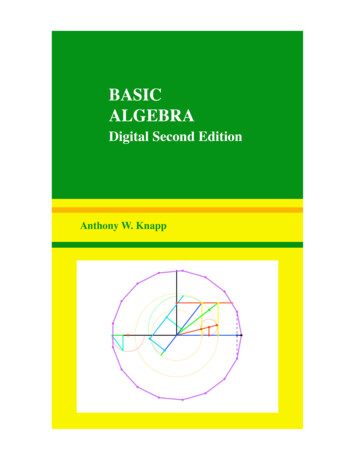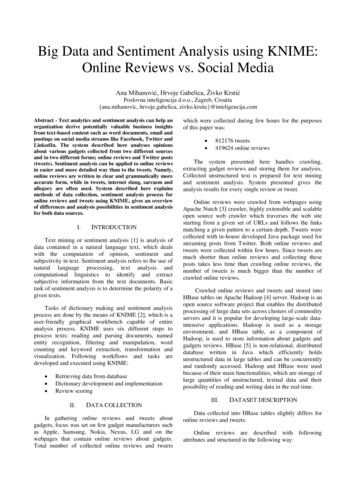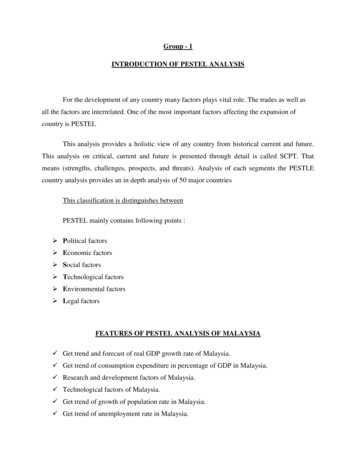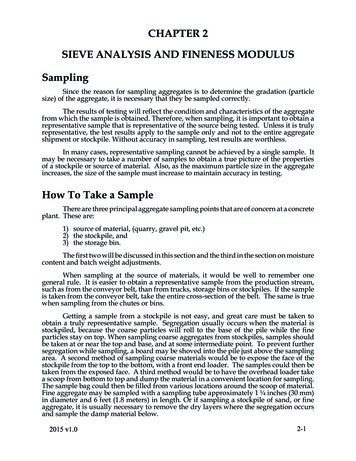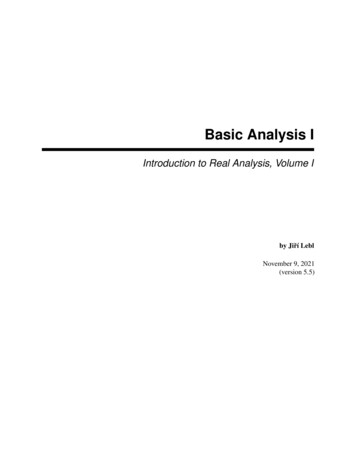
Transcription
Basic Analysis IIntroduction to Real Analysis, Volume Iby Jiří LeblNovember 9, 2021(version 5.5)
2Typeset in LATEX.Copyright 2009–2021 Jiří LeblThis work is dual licensed under the Creative Commons Attribution-Noncommercial-Share Alike4.0 International License and the Creative Commons Attribution-Share Alike 4.0 InternationalLicense. To view a copy of these licenses, visit https://creativecommons.org/licenses/by-nc-sa/4.0/ or https://creativecommons.org/licenses/by-sa/4.0/ or send a letterto Creative Commons PO Box 1866, Mountain View, CA 94042, USA.You can use, print, duplicate, share this book as much as you want. You can base your own noteson it and reuse parts if you keep the license the same. You can assume the license is either theCC-BY-NC-SA or CC-BY-SA, whichever is compatible with what you wish to do, your derivativeworks must use at least one of the licenses. Derivative works must be prominently marked as such.During the writing of this book, the author was in part supported by NSF grants DMS-0900885 andDMS-1362337.The date is the main identifier of version. The major version / edition number is raised only if therehave been substantial changes. Each volume has its own version number. Edition number started at4, that is, version 4.0, as it was not kept track of before.See https://www.jirka.org/ra/ for more information (including contact information, possibleupdates and errata).The LATEX source for the book is available for possible modification and customization at github:https://github.com/jirilebl/ra
ContentsIntroduction0.1 About this book . . . . . . . . . . . . . . . . . . . . . . . . . . . . . . . . . . . .0.2 About analysis . . . . . . . . . . . . . . . . . . . . . . . . . . . . . . . . . . . .0.3 Basic set theory . . . . . . . . . . . . . . . . . . . . . . . . . . . . . . . . . . . .1234Real Numbers1.1 Basic properties . . . . . . . . . . . .1.2 The set of real numbers . . . . . . . .1.3 Absolute value and bounded functions1.4 Intervals and the size of R . . . . . .1.5 Decimal representation of the reals . .Sequences and Series2.1 Sequences and limits . . . . . . . . . . . . . . . . . .2.2 Facts about limits of sequences . . . . . . . . . . . . .2.3 Limit superior, limit inferior, and Bolzano–Weierstrass2.4 Cauchy sequences . . . . . . . . . . . . . . . . . . . .2.5 Series . . . . . . . . . . . . . . . . . . . . . . . . . .2.6 More on series . . . . . . . . . . . . . . . . . . . . . .5578.212126333841.47475667778092Continuous Functions3.1 Limits of functions . . . . . . . . . . . .3.2 Continuous functions . . . . . . . . . . .3.3 Min-max and intermediate value theorems3.4 Uniform continuity . . . . . . . . . . . .3.5 Limits at infinity . . . . . . . . . . . . .3.6 Monotone functions and continuity . . . .103103111118125131135The Derivative4.1 The derivative . . . . . .4.2 Mean value theorem . . .4.3 Taylor’s theorem . . . .4.4 Inverse function theorem.141141147155159.
45CONTENTSThe Riemann Integral5.1 The Riemann integral . . . . . . .5.2 Properties of the integral . . . . .5.3 Fundamental theorem of calculus .5.4 The logarithm and the exponential5.5 Improper integrals . . . . . . . . .1631631721801861926Sequences of Functions2056.1 Pointwise and uniform convergence . . . . . . . . . . . . . . . . . . . . . . . . . 2056.2 Interchange of limits . . . . . . . . . . . . . . . . . . . . . . . . . . . . . . . . . 2126.3 Picard’s theorem . . . . . . . . . . . . . . . . . . . . . . . . . . . . . . . . . . . 2237Metric Spaces7.1 Metric spaces . . . . . . . . . . . . . . . . . .7.2 Open and closed sets . . . . . . . . . . . . . .7.3 Sequences and convergence . . . . . . . . . . .7.4 Completeness and compactness . . . . . . . . .7.5 Continuous functions . . . . . . . . . . . . . .7.6 Fixed point theorem and Picard’s theorem again.229229237246251259267Further Reading271Index273List of Notation279
Introduction0.1About this bookThis first volume is a one semester course in basic analysis. Together with the second volume it is ayear-long course. It started its life as my lecture notes for teaching Math 444 at the University ofIllinois at Urbana-Champaign (UIUC) in Fall semester 2009. Later I added the metric space chapterto teach Math 521 at University of Wisconsin–Madison (UW). Volume II was added to teach Math4143/4153 at Oklahoma State University (OSU). A prerequisite for these courses is usually a basicproof course, using for example [H], [F], or [DW].It should be possible to use the book for both a basic course for students who do not necessarilywish to go to graduate school (such as UIUC 444), but also as a more advanced one-semester coursethat also covers topics such as metric spaces (such as UW 521). Here are my suggestions for whatto cover in a semester course. For a slower course such as UIUC 444:§0.3, §1.1–§1.4, §2.1–§2.5, §3.1–§3.4, §4.1–§4.2, §5.1–§5.3, §6.1–§6.3For a more rigorous course covering metric spaces that runs quite a bit faster (such as UW 521):§0.3, §1.1–§1.4, §2.1–§2.5, §3.1–§3.4, §4.1–§4.2, §5.1–§5.3, §6.1–§6.2, §7.1–§7.6It should also be possible to run a faster course without metric spaces covering all sections ofchapters 0 through 6. The approximate number of lectures given in the section notes through chapter6 are a very rough estimate and were designed for the slower course. The first few chapters of thebook can be used in an introductory proofs course as is done, for example, at Iowa State UniversityMath 201, where this book is used in conjunction with Hammack’s Book of Proof [H].With volume II one can run a year-long course that also covers multivariable topics. It maymake sense in this case to cover most of the first volume in the first semester while leaving metricspaces for the beginning of the second semester.The book normally used for the class at UIUC is Bartle and Sherbert, Introduction to RealAnalysis third edition [BS]. The structure of the beginning of the book somewhat follows thestandard syllabus of UIUC Math 444 and therefore has some similarities with [BS]. A majordifference is that we define the Riemann integral using Darboux sums and not tagged partitions.The Darboux approach is far more appropriate for a course of this level.Our approach allows us to fit a course such as UIUC 444 within a semester and still spend sometime on the interchange of limits and end with Picard’s theorem on the existence and uniqueness ofsolutions of ordinary differential equations. This theorem is a wonderful example that uses manyresults proved in the book. For more advanced students, material may be covered faster so that wearrive at metric spaces and prove Picard’s theorem using the fixed point theorem as is usual.
6INTRODUCTIONOther excellent books exist. My favorite is Rudin’s excellent Principles of MathematicalAnalysis [R2] or, as it is commonly and lovingly called, baby Rudin (to distinguish it from his othergreat analysis textbook, big Rudin). I took a lot of inspiration and ideas from Rudin. However,Rudin is a bit more advanced and ambitious than this present course. For those that wish to continuemathematics, Rudin is a fine investment. An inexpensive and somewhat simpler alternative to Rudinis Rosenlicht’s Introduction to Analysis [R1]. There is also the freely downloadable Introduction toReal Analysis by William Trench [T].A note about the style of some of the proofs: Many proofs traditionally done by contradiction,I prefer to do by a direct proof or by contrapositive. While the book does include proofs bycontradiction, I only do so when the contrapositive statement seemed too awkward, or whencontradiction follows rather quickly. In my opinion, contradiction is more likely to get beginningstudents into trouble, as we are talking about objects that do not exist.I try to avoid unnecessary formalism where it is unhelpful. Furthermore, the proofs and thelanguage get slightly less formal as we progress through the book, as more and more details are leftout to avoid clutter.As a general rule, I use : instead of to define an object rather than to simply show equality.I use this symbol rather more liberally than is usual for emphasis. I use it even when the context is“local,” that is, I may simply define a function f (x) : x2 for a single exercise or example.Finally, I would like to acknowledge Jana Maříková, Glen Pugh, Paul Vojta, Frank Beatrous,Sönmez Şahutoğlu, Jim Brandt, Kenji Kozai, Arthur Busch, Anton Petrunin, Mark Meilstrup,Harold P. Boas, Atilla Yılmaz, Thomas Mahoney, Scott Armstrong, and Paul Sacks, Matthias Weber,Manuele Santoprete, Robert Niemeyer, Amanullah Nabavi, for teaching with the book and giving melots of useful feedback. Frank Beatrous wrote the University of Pittsburgh version extensions, whichserved as inspiration for many more recent additions. I would also like to thank Dan Stoneham,Jeremy Sutter, Eliya Gwetta, Daniel Pimentel-Alarcón, Steve Hoerning, Yi Zhang, Nicole Caviris,Kristopher Lee, Baoyue Bi, Hannah Lund, Trevor Mannella, Mitchel Meyer, Gregory Beauregard,Chase Meadors, Andreas Giannopoulos, Nick Nelsen, Ru Wang, Trevor Fancher, Brandon Tague,Wang KP, an anonymous reader or two, and in general all the students in my classes for suggestionsand finding errors and typos.
0.2. ABOUT ANALYSIS0.27About analysisAnalysis is the branch of mathematics that deals with inequalities and limits. The present coursedeals with the most basic concepts in analysis. The goal of the course is to acquaint the reader withrigorous proofs in analysis and also to set a firm foundation for calculus of one variable (and severalvariables if volume II is also considered).Calculus has prepared you, the student, for using mathematics without telling you why whatyou learned is true. To use, or teach, mathematics effectively, you cannot simply know what is true,you must know why it is true. This course shows you why calculus is true. It is here to give you agood understanding of the concept of a limit, the derivative, and the integral.Let us use an analogy. An auto mechanic that has learned to change the oil, fix brokenheadlights, and charge the battery, will only be able to do those simple tasks. He will be unable towork independently to diagnose and fix problems. A high school teacher that does not understandthe definition of the Riemann integral or the derivative may not be able to properly answer all thestudents’ questions. To this day I remember several nonsensical statements I heard from my calculusteacher in high school, who simply did not understand the concept of the limit, though he could “do”the problems in the textbook.We start with a discussion of the real number system, most importantly its completeness property,which is the basis for all that comes after. We then discuss the simplest form of a limit, the limit ofa sequence. Afterwards, we study functions of one variable, continuity, and the derivative. Next, wedefine the Riemann integral and prove the fundamental theorem of calculus. We discuss sequencesof functions and the interchange of limits. Finally, we give an introduction to metric spaces.Let us give the most important difference between analysis and algebra. In algebra, we proveequalities directly; we prove that an object, a number perhaps, is equal to another object. In analysis,we usually prove inequalities, and we prove those inequalities by estimating. To illustrate the point,consider the following statement.Let x be a real number. If x ε is true for all real numbers ε 0, then x 0.This statement is the general idea of what we do in analysis. Suppose next we really wish toprove the equality x 0. In analysis, we prove two inequalities: x 0 and x 0. To prove theinequality x 0, we prove x ε for all positive ε. To prove the inequality x 0, we prove x εfor all positive ε.The term real analysis is a little bit of a misnomer. I prefer to use simply analysis. The othertype of analysis, complex analysis, really builds up on the present material, rather than being distinct.Furthermore, a more advanced course on real analysis would talk about complex numbers often. Isuspect the nomenclature is historical baggage.Let us get on with the show. . .
8INTRODUCTION0.3Basic set theoryNote: 1–3 lectures (some material can be skipped, covered lightly, or left as reading)Before we start talking about analysis, we need to fix some language. Modern* analysis uses thelanguage of sets, and therefore that is where we start. We talk about sets in a rather informal way,using the so-called “naïve set theory.” Do not worry, that is what majority of mathematicians use,and it is hard to get into trouble. The reader has hopefully seen the very basics of set theory andproof writing before, and this section should be a quick refresher.0.3.1SetsDefinition 0.3.1. A set is a collection of objects called elements or members. A set with no objectsis called the empty set and is denoted by 0/ (or sometimes by {}).Think of a set as a club with a certain membership. For example, the students who play chess aremembers of the chess club. The same student can be a member of many different clubs. However,do not take the analogy too far. A set is only defined by the members that form the set; two sets thathave the same members are the same set.Most of the time we will consider sets of numbers. For example, the setS : {0, 1, 2}is the set containing the three elements 0, 1, and 2. By “: ”, we mean we are defining what S is,rather than just showing equality. We write1 Sto denote that the number 1 belongs to the set S. That is, 1 is a member of S. At times we want tosay that two elements are in a set S, so we write “1, 2 S” as a shorthand for “1 S and 2 S.”Similarly, we write7 /Sto denote that the number 7 is not in S. That is, 7 is not a member of S.The elements of all sets under consideration come from some set we call the universe. Forsimplicity, we often consider the universe to be the set that contains only the elements we areinterested in. The universe is generally understood from context and is not explicitly mentioned. Inthis course, our universe will most often be the set of real numbers.While the elements of a set are often numbers, other objects, such as other sets, can be elementsof a set. A set may also contain some of the same elements as another set. For example,T : {0, 2}contains the numbers 0 and 2. In this case all elements of T also belong to S. We write T S. SeeFigure 1 for a diagram.* Theterm “modern” refers to late 19th century up to the present.
90.3. BASIC SET THEORYST0127Figure 1: A diagram of the example sets S and its subset T .Definition 0.3.2.(i) A set A is a subset of a set B if x A implies x B, and we write A B. That is, all membersof A are also members of B. At times we write B A to mean the same thing.(ii) Two sets A and B are equal if A B and B A. We write A B. That is, A and B containexactly the same elements. If it is not true that A and B are equal, then we write A 6 B.(iii) A set A is a proper subset of B if A B and A 6 B. We write A ( B.For the example S and T defined above, T S, but T 6 S. So T is a proper subset of S. If A B,then A and B are simply two names for the same exact set.To define sets, one often uses the set building notation, x A : P(x) .This notation refers to a subset of the set A containing all elements of A that satisfy the propertyP(x). Using S {0, 1, 2} as above, {x S : x 6 2} is the set {0, 1}. The notation is sometimesabbreviated as x : P(x) , that is, A is not mentioned when understood from context. Furthermore,x A is sometimes replaced with a formula to make the notation easier to read.Example 0.3.3: The following are sets including the standard notations.(i) The set of natural numbers, N : {1, 2, 3, . . .}.(ii) The set of integers, Z : {0, 1, 1, 2, 2, . . .}. (iii) The set of rational numbers, Q : mn : m, n Z and n 6 0 .(iv) The set of even natural numbers, {2m : m N}.(v) The set of real numbers, R.Note that N Z Q R.We create new sets out of old ones by applying some natural operations.Definition 0.3.4.(i) A union of two sets A and B is defined asA B : {x : x A or x B}.(ii) An intersection of two sets A and B is defined asA B : {x : x A and x B}.
10INTRODUCTION(iii) A complement of B relative to A (or set-theoretic difference of A and B) is defined asA \ B : {x : x A and x / B}.(iv) We say complement of B and write Bc instead of A \ B if the set A is either the entire universeor if it is the obvious set containing B, and is understood from context.(v) We say sets A and B are disjoint if A B 0./The notation Bc may be a little vague at this point. If the set B is a subset of the real numbers R,then Bc means R \ B. If B is naturally a subset of the natural numbers, then Bc is N \ B. If ambiguitycan arise, we use the set difference notation A \ B.ABAA BABA BBBBcA\BFigure 2: Venn diagrams of set operations, the result of the operation is shaded.We illustrate the operations on the Venn diagrams in Figure 2. Let us now establish one of mostbasic theorems about sets and logic.Theorem 0.3.5 (DeMorgan). Let A, B,C be sets. Then(B C)c Bc Cc ,(B C)c Bc Cc ,or, more generally,A \ (B C) (A \ B) (A \C),A \ (B C) (A \ B) (A \C).
110.3. BASIC SET THEORYProof. The first statement is proved by the second statement if we assume the set A is our “universe.”Let us prove A \ (B C) (A \ B) (A \C). Remember the definition of equality of sets. First,we must show that if x A \ (B C), then x (A \ B) (A \C). Second, we must also show that ifx (A \ B) (A \C), then x A \ (B C).So let us assume x A \ (B C). Then x is in A, but not in B nor C. Hence x is in A and not inB, that is, x A \ B. Similarly x A \C. Thus x (A \ B) (A \C).On the other hand suppose x (A \ B) (A \C). In particular, x (A \ B), so x A and x / B.Also as x (A \C), then x / C. Hence x A \ (B C).The proof of the other equality is left as an exercise.The result above we called a Theorem, while most results we call a Proposition, and a few wecall a Lemma (a result leading to another result) or Corollary (a quick consequence of the precedingresult). Do not read too much into the naming. Some of it is traditional, some of it is stylistic choice.It is not necessarily true that a Theorem is always “more important” than a Proposition or a Lemma.We will also need to intersect or union several sets at once. If there are only finitely many, thenwe simply apply the union or intersection operation several times. However, suppose we have aninfinite collection of sets (a set of sets) {A1 , A2 , A3 , . . .}. We define [n 1 \n 1An : {x : x An for some n N},An : {x : x An for all n N}.We can also have sets indexed by two natural numbers. For example, we can have the set of sets{A1,1 , A1,2 , A2,1 , A1,3 , A2,2 , A3,1 , . . .}. Then we write! [ [An,m n 1 m 1 [ [n 1m 1An,m .And similarly with intersections.It is not hard to see that we can take the unions in any order. However, switching the order ofunions and intersections is not generally permitted without proof. For instance, \ [However,{k N : mk n} [0/ 0./n 1 m 1n 1 [ \ \{k N : mk n} m 1 n 1N N.m 1Sometimes, the index set is not the natural numbers. In such a case we require a more generalnotation. Suppose I is some set and for each λ I, there is a set Aλ . Then we define[λ IAλ : {x : x Aλ for some λ I},\λ IAλ : {x : x Aλ for all λ I}.
120.3.2INTRODUCTIONInductionWhen a statement includes an arbitrary natural number, a common method of proof is the principleof induction. We start with the set of natural numbers N {1, 2, 3, . . .}, and we give them theirnatural ordering, that is, 1 2 3 4 · · · . By S N having a least element, we mean that thereexists an x S, such that for every y S, we have x y.The natural numbers N ordered in the natural way possess the so-called well ordering property.We take this property as an axiom; we simply assume it is true.Well ordering property of N. Every nonempty subset of N has a least (smallest) element.The principle of induction is the following theorem, which is in a sense* equivalent to the wellordering property of the natural numbers.Theorem 0.3.6 (Principle of induction). Let P(n) be a statement depending on a natural number n.Suppose that(i) (basis statement) P(1) is true.(ii) (induction step) If P(n) is true, then P(n 1) is true.Then P(n) is true for all n N.Proof. Let S be the set of natural numbers m for which P(m) is not true. Suppose for contradictionthat S is nonempty. Then S has a least element by the well ordering property. Call m S the leastelement of S. We know 1 / S by hypothesis. So m 1, and m 1 is a natural number as well.Since m is the least element of S, we know that P(m 1) is true. But the induction step says thatP(m 1 1) P(m) is true, contradicting the statement that m S. Therefore, S is empty and P(n)is true for all n N.Sometimes it is convenient to start at a different number than 1, all that changes is the labeling.The assumption that P(n) is true in “if P(n) is true, then P(n 1) is true” is usually called theinduction hypothesis.Example 0.3.7: Let us prove that for all n N,2n 1 n!(recall n! 1 · 2 · 3 · · · n).We let P(n) be the statement that 2n 1 n! is true. By plugging in n 1, we see that P(1) is true.Suppose P(n) is true. That is, suppose 2n 1 n! holds. Multiply both sides by 2 to obtain2n 2(n!).As 2 (n 1) when n N, we have 2(n!) (n 1)(n!) (n 1)!. That is,2n 2(n!) (n 1)!,and hence P(n 1) is true. By the principle of induction, P(n) is true for all n N. In other words,2n 1 n! is true for all n N.* To be completely rigorous, this equivalence is only true if we also assume as an axiom that n 1 exists for allnatural numbers bigger than 1, which we do. In this book, we are assuming all the usual arithmetic holds.
130.3. BASIC SET THEORYExample 0.3.8: We claim that for all c 6 1,1 c c2 · · · cn 1 cn 1.1 cProof: It is easy to check that the equation holds with n 1. Suppose it is true for n. Then1 c c2 · · · cn cn 1 (1 c c2 · · · cn ) cn 11 cn 1 cn 11 c1 cn 1 (1 c)cn 1 1 cn 21 c .1 c Sometimes, it is easier to use in the inductive step that P(k) is true for all k 1, 2, . . . , n, not justfor k n. This principle is called strong induction and is equivalent to the normal induction above.The proof of that equivalence is left as an exercise.Theorem 0.3.9 (Principle of strong induction). Let P(n) be a statement depending on a naturalnumber n. Suppose that(i) (basis statement) P(1) is true.(ii) (induction step) If P(k) is true for all k 1, 2, . . . , n, then P(n 1) is true.Then P(n) is true for all n N.0.3.3FunctionsInformally, a set-theoretic function f taking a set A to a set B is a mapping that to each x Aassigns a unique y B. We write f : A B. An example function f : S T taking S : {0, 1, 2}to T : {0, 2} can be defined by assigning f (0) : 2, f (1) : 2, and f (2) : 0. That is, a functionf : A B is a black box, into which we stick an element of A and the function spits out an elementof B. Sometimes f is called a mapping or a map, and we say f maps A to B.Often, functions are defined by some sort of formula; however, you should really think of afunction as just a very big table of values. The subtle issue here is that a single function can haveseveral formulas, all giving the same function. Also, for many functions, there is no formula thatexpresses its values.To define a function rigorously, first let us define the Cartesian product.Definition 0.3.10. Let A and B be sets. The Cartesian product is the set of tuples defined as A B : (x, y) : x A, y B . For instance, {a, b} {c, d} (a, c), (a, d), (b, c), (b, d) . A more complicated example is theset [0, 1] [0, 1]: a subset of the plane bounded by a square with vertices (0, 0), (0, 1), (1, 0), and(1, 1). When A and B are the same set we sometimes use a superscript 2 to denote such a product.For example, [0, 1]2 [0, 1] [0, 1] or R2 R R (the Cartesian plane).
14INTRODUCTIONDefinition 0.3.11. A function f : A B is a subset f of A B such that for each x A, there existsa unique y B for which (x, y) f . We write f (x) y. Sometimes the set f is called the graph ofthe function rather than the function itself.The set A is called the domain of f (and sometimes confusingly denoted D( f )). The setR( f ) : {y B : there exists an x A such that f (x) y}is called the range of f . The set B is called the codomain of f .It is possible that the range R( f ) is a proper subset of the codomain B, while the domain of f isalways equal to A. We generally assume that the domain of f is nonempty.Example 0.3.12: From calculus, you are most familiar with functions taking real numbers to realnumbers. However, you saw some other types of functions as well. The derivative is a functionmapping the set of differentiable functions to the set of all functions. Another example is theLaplace transform, which also takes functions to functions. Yet another example is thefunction thatRtakes a continuous function g defined on the interval [0, 1] and returns the number 01 g(x) dx.Definition 0.3.13. Consider a function f : A B. Define the image (or direct image) of a subsetC A as f (C) : f (x) B : x C .Define the inverse image of a subset D B as f 1 (D) : x A : f (x) D .In particular, R( f ) f (A), the range is the direct image of the domain A.1fa2b3c4df ({1, 2, 3, 4}) {b, c, d}f ({1, 2, 4}) {b, d}f ({1}) {b}f 1 ({a, b, c}) {1, 3, 4}f 1 ({a}) 0/f 1 ({b}) {1, 4}Figure 3: Example of direct and inverse images for the function f : {1, 2, 3, 4} {a, b, c, d} defined byf (1) : b, f (2) : d, f (3) : c, f (4) : b. Example 0.3.14: Define the function f : R R by f (x) : sin(πx). Then f [0, 1/2] [0, 1],f 1 {0} Z, etc.Proposition 0.3.15. Consider f : A B. Let C, D be subsets of B. Thenf 1 (C D) f 1 (C) f 1 (D),f 1 (C D) f 1 (C) f 1 (D), cf 1 (Cc ) f 1 (C) .
150.3. BASIC SET THEORYRead the last line of the proposition as f 1 (B \C) A \ f 1 (C).Proof. We start with the union. If x f 1 (C D), then x is taken to C or D, that is, f (x) C orf (x) D. Thus f 1 (C D) f 1 (C) f 1 (D). Conversely if x f 1 (C), then x f 1 (C D).Similarly for x f 1 (D). Hence f 1 (C D) f 1 (C) f 1 (D), and we have equality.The rest of the proof is left as an exercise.The proposition does not hold for direct images. We do have the following weaker result.Proposition 0.3.16. Consider f : A B. Let C, D be subsets of A. Thenf (C D) f (C) f (D),f (C D) f (C) f (D).The proof is left as an exercise.Definition 0.3.17. Let f : A B be a function. The function f is said to be injective or one-to-oneif f (x1 ) f (x2 ) implies x1 x2 . In other words, f is injective if for all y B, the set f 1 ({y}) isempty or consists of a single element. We call such an f an injection.If f (A) B, then we say f is surjective or onto. In other words, f is surjective if the range andthe codomain of f are equal. We call such an f a surjection.If f is both an surjective and injective, then we say f is bijective or that f is a bijection.When f : A B is a bijection, then the inverse image of a single element, f 1 ({y}), is always aunique element of A. We then consider f 1 as a function f 1 : B A and we write simply f 1 (y).In this case, we call f 1 the inversefunction of f . For instance, for the bijection f : R R defined 3 13by f (x) : x , we have f (x) x.Definition 0.3.18. Consider f : A B and g : B C. The composition of the functions f and g isthe function g f : A C defined as (g f )(x) : g f (x) .For example, if f : R R is f (x) : x3 and g : R R is g(y) sin(y), then (g f )(x) sin(x3 ).0.3.4Relations and equivalence classesWe often compare two objects in some way. We say 1 2 for natural numbers, or 1/2 2/4 forrational numbers, or {a, c} {a, b, c} for sets. The ‘ ’, ‘ ’, and ‘ ’ are examples of relations.Definition 0.3.19. Given a set A, a binary relation on A is a subset R A A, which are thosepairs where the relation is said to hold. Instead of (a, b) R, we write a R b.Example 0.3.20: Take A : {1, 2, 3}. Consider the relation ‘ ’. The corresponding set of pairs is (1, 2), (1, 3), (2, 3) . So 1 2holds as (1, 2) is in the corresponding set of pairs, but 3 1 does not hold as (3, 1) is not in the set.Similarly, the relation ‘ ’ is defined by the set of pairs (1, 1), (2, 2), (3, 3) .Any subset of A A is a relation. Let us define the relation † via (1, 2), (2, 1), (2, 3), (3, 1) ,then 1 † 2 and 3 † 1 are true, but 1 † 3 is not.
16INTRODUCTIONDefinition 0.3.21. Let R be a relation on a set A. Then R is said to be(i) Reflexive if a R a for all a A.(ii) Symmetric if a R b implies b R a.(iii) Transitive if a R b and b R c implies a R c.If R is reflexive, symmetric, and transitive, then it is said to be an equivalence relation.Example 0.3.22: Let A : {1, 2, 3} as above. The relation ‘ ’ is transitive, but neither reflexive norsymmetric. The
0.2. ABOUT ANALYSIS 7 0.2 About analysis Analysis is the branch of mathematics that deals with inequalities and limits. The present course deals with the most basic concepts in analysis. The goal of the course is to acquaint the reader with rigorous proofs in analysis and also to set a



